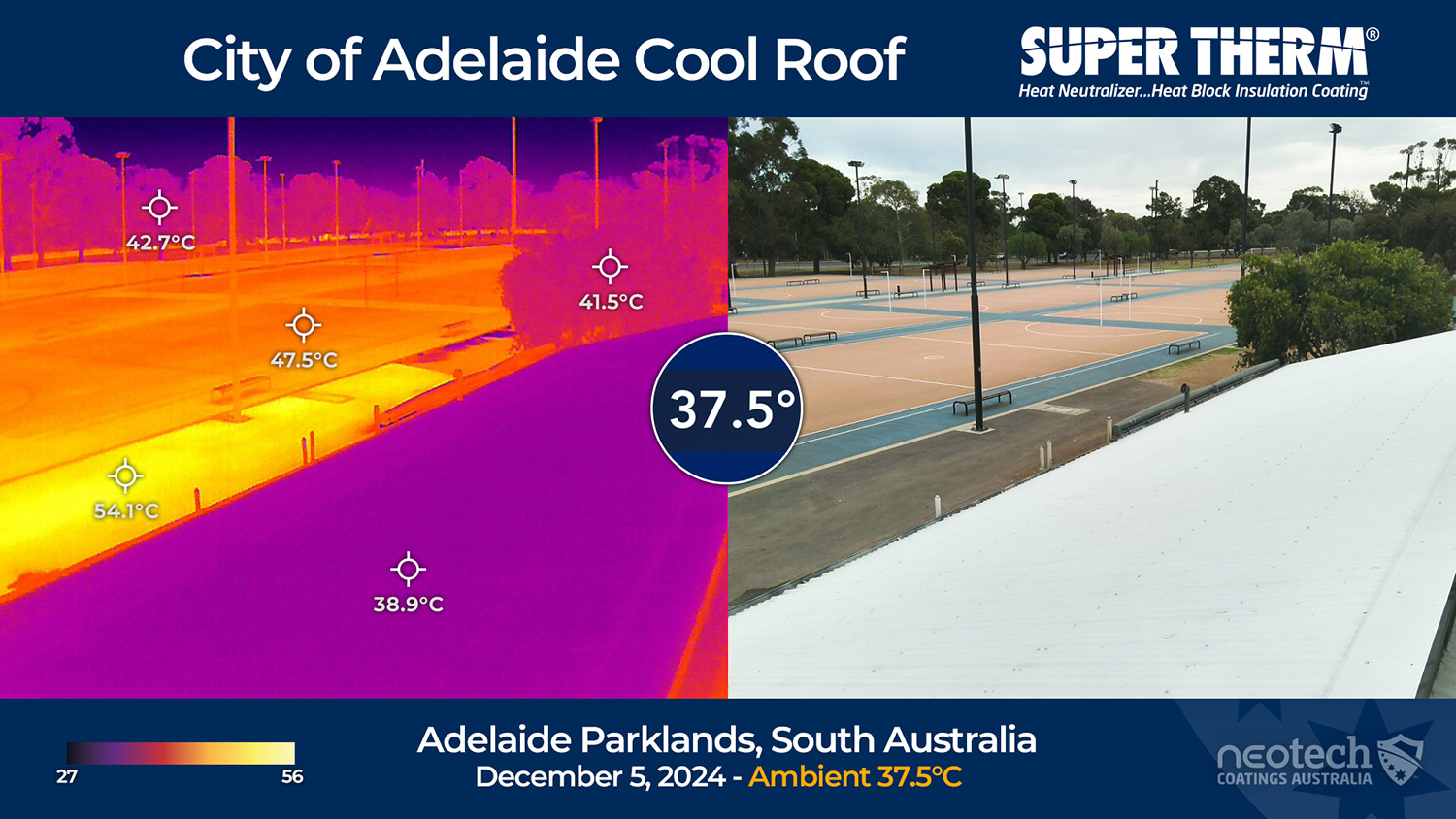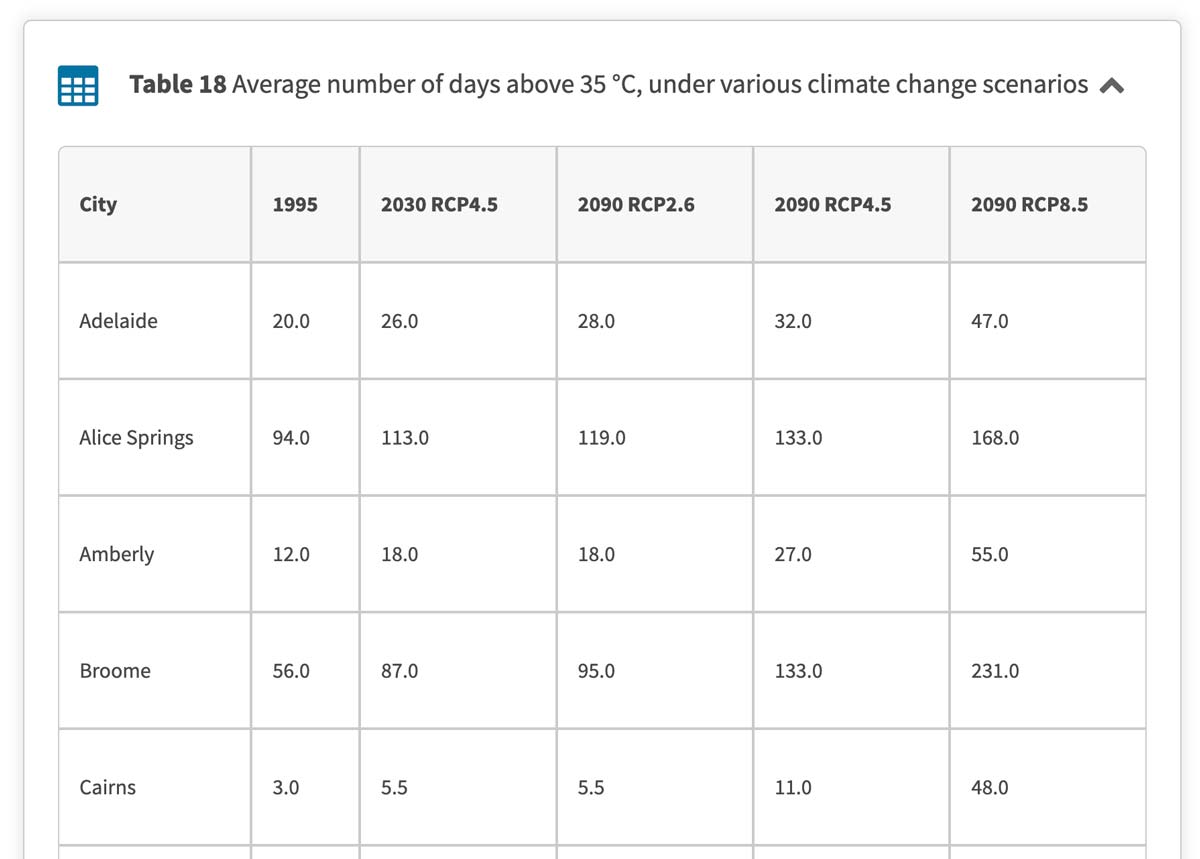City of Adelaide Cool Roof Pilot 2022-2023
Industry: Government & Sustainability
Location: Adelaide South West Parklands, South Australia
Products: Super Therm®
Global Partner: Superior Products International II, Inc.

It’s a HOT DAY in Adelaide at 37.5°C…at least the City of Adelaide Cool Roof is smashn’ the heat with SUPER THERM. Ambient temp. is 37.5°C and the roof is only 1.4°C over. It’s cooler than the trees by 2-3°C and cooler than the bitumen by nearly 17°C and it was overcast. Inside the building was only 28°C, super cool coating!
City of Adelaide Cool Roof Trial Report pdf
“This means that even during the heatwave, these cool roofs do not contribute much to the urban heat island effect.”
To build the Council’s knowledge and understanding on the subject, they partnered with the University of Adelaide to undertake a trial and study using Super Therm® ceramic cool roof coating. Key findings of the Cool Roofing trial were:
- The cool roof coating is shown to reduce the surface temperature of conventional dark roof facing west up to 17°C.
- The cool roof coating resulted in an average air temperature reduction of 1.2°C at 200mm above the roof surface and 1.1°C inside the roof space with insulation below the metal roof sheets and 1.4°C indoor space cooling.
- The cooling impact Super Therm® is the highest in warm and sunny weather conditions. With metal having high thermal conductivity and thin profile on roofs, the cooling impact of the coating is reduced in colder ambient temperatures and under cloudy sky. This is beneficial since there will be less cooling penalty in colder months of the year than the benefit on the hotter months.
- Super Therm® can effectively maintain the indoor air temperature up to 6°C lower than the outdoor air temperature during heatwaves.
Results from the study informed the development of priorities within the Integrated Climate Strategy 2030 adopted by Council in June 2024.

The City of Adelaide Cool Roof Report
Summary of City of Adelaide Cool Roof Pilot Results
The City of Adelaide and their Cool Roof Pilot with Super Therm®. It was prepared by Adelaide University, School of Architecture and Civil Engineering. The report is very positive; particularly as it was a mild summer in Adelaide. This will ensure long term performance and both energy and carbon savings. For more details contact the City of Adelaide Park Lands Policy and Sustainability.
The results are certainly encouraging and shows the effectiveness of the coating product in reducing the exterior surface temperature as well as the interior temperature of the building.
The Built Environment Absorbs Heat – Super Therm Blocks It!
Bitumen roads and building materials collectively absorb and store the sun’s solar heat that contributes to excessive heat in our cities like Brisbane, Sydney, Melbourne, Darwin, Adelaide and Perth. These dense urban areas is known as the urban heat island effect.
The heat islands are significantly hotter than temperatures in surrounding suburbs and rural areas and impacts the well being of communities as well as increasing air conditioning demands which increases carbon emissions and costs.
The number of extreme heat days are predicted to increase and exacerbate the urban heat island effect, the City of Adelaide is working to better understand the environmental impacts and reduce heat islands.
In 2019/2020, the Council undertook a Cool Road Adelaide pilot with other stakeholders in which a treated road was monitored to see how specialised coatings reduced surface and ambient air temperatures in the city.
Like bitumen roads, normal roof materials heat up significantly by absorbing the sun’s solar heat. The darker the roof, the hotter it gets. Ultimately this heat increases air-conditioning demands, carbon emissions and energy costs.
In April 2022 the City of Adelaide engaged NEOtech Coatings to apply Super Therm® Ceramic Cool Coating as part of their Cool Roof Pilot on two buildings in the southern Adelaide parklands.
As an example, a netball clubrooms had a dark, Deep Ocean Colorbond® roof. On a 25°C day the external roof temperature was 53°C. The other building had a lighter Surfmist® roof and recorded 45°C. The heat loads into the metal roof and transfers into the building, pushing up the need for air conditioning.
The roofs were pressure cleaned and repaired in a day and the Super Therm application was applied the next day.
After application with Super Therm® on a 27° day, the netball clubrooms roof was a very cool 23°C compared with previous high of 53°C on the uncoated roof. This 225% improvement means it was much cooler inside the building as there was a tiny amount of heat loading into the roof space and traditional insulation.


The Adelaide University independently researched data as part of the cool roof pilot. Based on urban heat mapping and testing sensors before and after application, they are collecting data both on the roof and inside with a final report post summer 2022/23.
Super Therm® was developed with NASA over 6 years. It also prevents:
- Roof thermal shock and Extends roof life
- Fire rated as Class “A” by NASA
- Reduces CO2 emissions towards Net Zero
- Inhibits mould and mildew
- Proven 20-50% energy reduction
- Less visual impact because it’s not shiny white to block the heat load
- Reduces condensation…and more
The City of Adelaide’s investment will last well over 20 years against the rising threat of heatwaves, blackouts and increased sustained heat events. They will also be able to make future decisions with local verified data in relation to adapting buildings in Adelaide for climate change.
While cities globally manage growing heat threats, Super Therm® is used around the world to solve heat challenges and the City of Adelaide are future proofing to protect their important assets and the community’s well being.
MEDIA
Cool roofs and how to get them:
City of Adelaide Council trials a space-age ceramic coating as temperatures skyrocket
The Fifth Estate, 17 May 2022
City of Adelaide post: May 6, 2022
Did you know ditching dark roofs could help ease the effects of climate change? 🌞
A cool roof can lower local outside air and inside building temperatures, saving money on air-conditioning and lessening the urban heat island effect. 🔥 That’s why we’re working with The University of Adelaide to research and trial a cool new roof type. 😎
Based on the data provided by the Urban Heat Mapping Project and University testing, we have pinpointed two buildings for the trial; the Horticultural Building and SA Uniting Church Netball Association Club Rooms in Park 22 due to their north facing unshaded and relatively hot roofs.
Sensors have been installed on the roofs and inside the buildings to collect 3 months of baseline data. This week, the cool roof coating is being applied, the sensors will then collect more data after the application of the cool roof coating.
A final report, post summer 2022/23, will be provided detailing the results. These results will then be used to make decisions about building materials in the future, equipping us with local verified data to use when engaging the community, developers and partners in relation to adapting buildings and our city to climate change.
Find out more about how we’re responding to climate change: cityofadelaide.com.au/about-adelaide/our-sustainable-city/climate-ready-city/
The City of Adelaide Cool Roof Report











